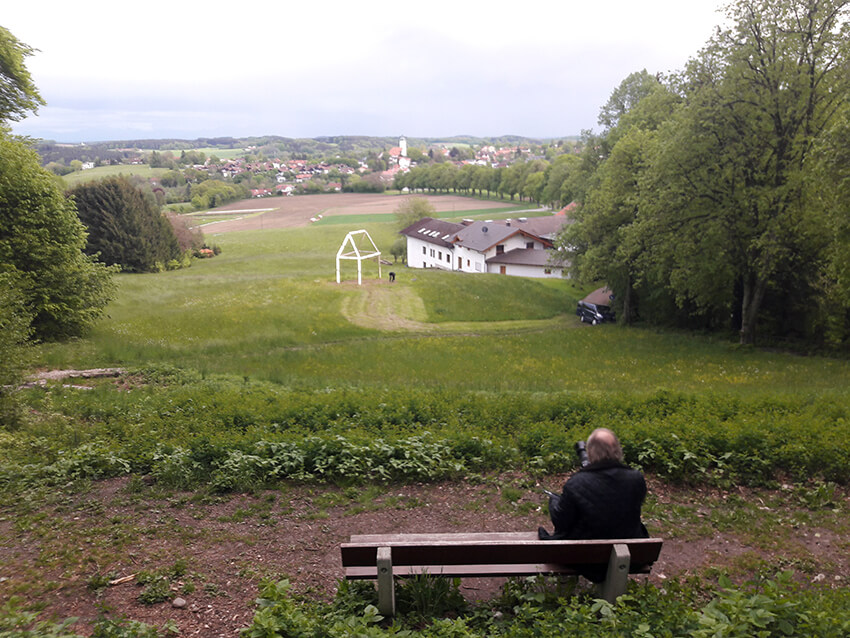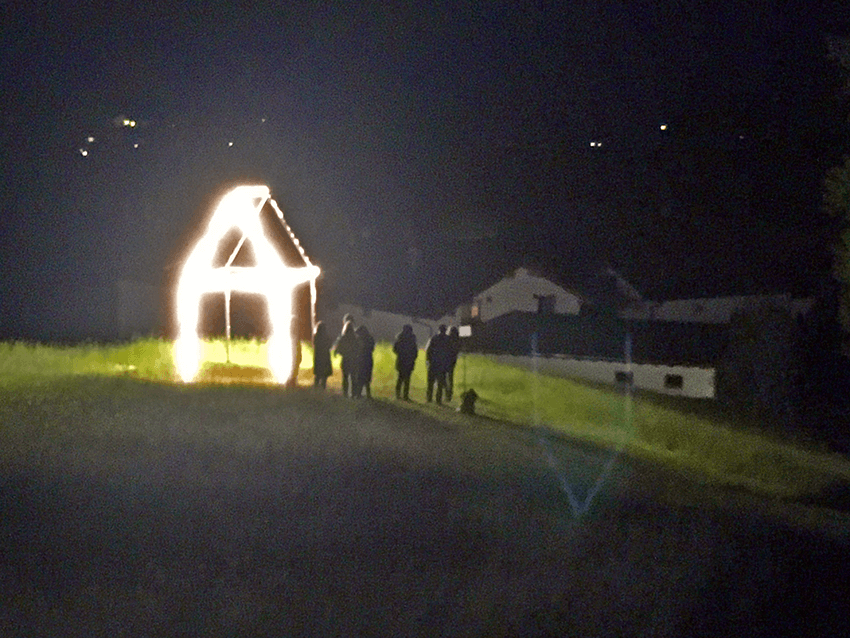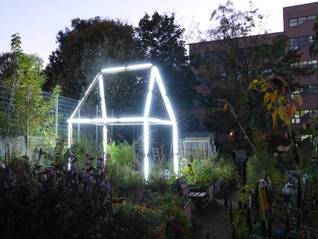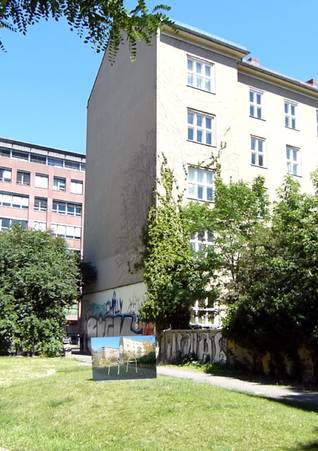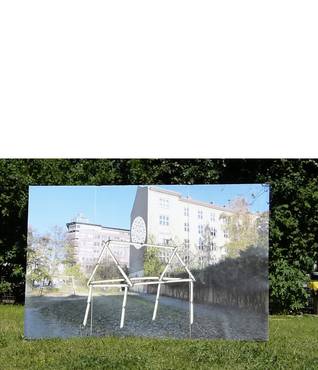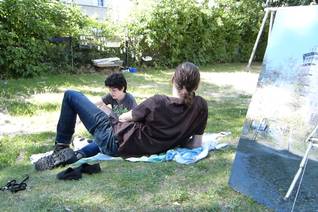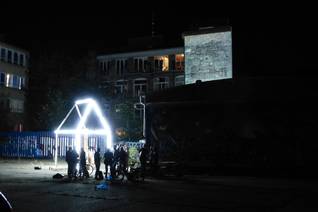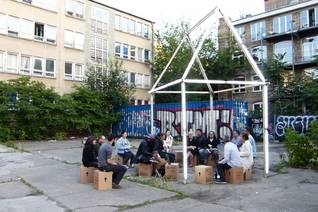Projektor
Baukasten für eine imaginäre Stadt
Ort: Stadtraum Berlin-Mitte
Zeitraum: Juni-September 2017, August-Dezember 2019
Objekt: interaktive Stadtraumskulptur
Material: Architektur, Holz, Neonlampen, Beamerprojektion
Größe: Skulptur 3,70 x 2,50 x 5,00 m, Höhe: Projektion 14 m
Projektor- Baukasten für eine imaginäre Stadt- ist eine Serie von temporären Installationen im Stadtraum. Thema und Orte der temporären Installationen der Projektor-Reihe sind vorzugsweise noch vorhandene freie, öffentlich zugängliche innerstädtische Flächen bzw. potentielle Baugrundstücke: Hier sind dokumentiert die derzeit als Parkplatz genutzte Fläche Schönhauser Allee 9, Rosa-Luxemburg-Platz, Ruheplatzstraße und Moritzplatz.
Das nomadisierende Projekt greift aktuelle Fragestellungen zur immer weiter fortschreitenden Verdichtung und Kommerzialisierung des Stadtraums auf und nutzt dafür neben abendlichen Fassadenprojektionen von zum Thema passenden grafischen künstlerischen Beiträgen aus einem jeweils dafür gestarteten open call immer eine freistehende, mit Neonlampen bestückte hausartige Holzkonstruktion- „Lichthaus“. Dieses Objekt/Raumzeichnung wird dabei ein wiedererkennbares mobiles visuelles Zeichen, das auf schützenswerte öffentlich zugängliche Flächen und kulturelle Räume wie auch gefährdete Grünflächen hinweist.
Die visuelle Verbindung der Linien dieser Raumzeichnung mit der architektonischen Umgebung ermöglicht dabei ganz neue Sichtweisen auf die jeweiligen Raumsituationen. Die Skulptur lädt AnwohnerInnen und BesucherInnen und soziale Netzwerke ein, sich dort zu treffen und Gedanken und Ideen auszutauschen. Das Projekt thematisiert so die weiter fortschreitende Verdichtung und Kommerzialisierung des Stadtraums, der auch immer mehr öffentliche Grünflächen zum Opfer fallen. Projektor entwickelte hierfür eine freistehende, mit Neonröhren bestückte hausartige Holzkonstruktion. Dieses Objekt/Raumzeichnung funktioniert dabei als mobiles visuelles Zeichen, das neben der Kritik des “Neubaus” auf schützenswerte, öffentlich zugängliche Flächen, Kultur- und Grün- Räume verweist.
Das Objekt wird ergänzt durch eine Fassadenprojektion mit Arbeiten von Heike Hamann, Christian Sievers, Anke Westermann, Antje Vowinckel, Karsten Trappe, Monika Filz, Erik Göngrich, Daniela Doreen Revink, Katja Bröskamp und Antje Höricht, Ae Hee Lee, Tony Just, Caroline Bayer.
Projektor kooperierte 2017 mit „The Real Estate Show Extended/Berlin“, eine Gruppenausstellung zum Thema „Gentrifizierung, Immobilienspekulation und der Ausverkauf der Stadt“, 03.06.-24.06.2017 Kunstpunkt Berlin, Schlegelstr. 6, 10115 Berlin.
Projektor wurde 2017 gefördert vom Fachbereich für Kunst und Kultur, Bezirk Mitte, Bezirkskulturfonds.
aus → "Art as /is social" von Lianne Mol:
Projektor is a project by Berlin-based artist Anke Westermann. It consists of a nomadic, house-like wooden construction equipped with neon lights. This spatial object functions as a mobile visual sign that critiques hegemonic constructions in publicly accessible spaces that are worth protecting. Projektor manifested first in empty inner-city spaces and potential construction sites - locations that have so far escaped economic exploitation - where it aims to raise awareness for the increasing compression and commercialization of urban space, and the decreasing of green areas in the city. What does the usage of public space mean? How can spaces be created that can be used by all actors and neighbours involved? Which conflicts and challenges do we face? How can we build a shared city?
The point of departure for Projektor is a toolbox from which a spatial sculpture can grow that functions as a ‘projector’ for subjective phenomena in the urban landscape. It uses scaled elements of built architecture, modified and combined anew. Projektor projects individual imaginations of an alternative city. The idea is to involve not just users but also artists, architects, students, associations and other social networks in the construction of social space. Projektor generates a creative space in which individual artistic actions are made possible on site and in interaction with the surrounding context. This polyphonic approach expresses an alternative view on spatial construction and urban development. Continuously, the empty space, the ‘void’, is contained, made visible, reversed and transformed, and as such recognized as an object in itself. The theme of inverse spatiality and utopian spatial design through participation is given a form. As such, it establishes a whole new, heterogeneous architectural structure in central urban spaces, activating their social potential. The goal is to confront the methods of spatial construction and to contribute to optimizing future urban planning processes in social, inclusive and playful ways. Until now, Projektor has been installed in three different locations in Berlin. Its first appearance was on a parking lot on Schönhauser Allee, where the illuminated house hosted thematic discussions with experts, theorists, neighbours and politicians, and was complemented with projections by different artists. It was cooperating part of the group exhibition The Real Estate Show Extended/Berlin by KunstpunktBerlin, on themes of gentrification, real estate speculation and ‘sell-out’ of the city. The installation should have made its premiere at the ‘Zola Garten’, on a piece of green land between Linienstraße, Zolastraße and Torstraße. The use and ownership of this space have long been debated, and eventually Anke was not legally allowed to install Projektor here, only emphasizing the importance of the issues it addresses. Instead of a spatial object, a visual representation of the illuminated house appeared here. On its second location in front of the Volksbühne on Rosa-Luxemburg-Platz, Projektor was part of the B61-12 transmedial theatre intervention. This demonstration questioned the Volksbühne policies, and more generally engaged with the topic of cultural and urban politics. Here, Projektor contributed the critical artistic space for reflection and subversion that B61-12 strived for. Finally, in community garden Himmelbeet, Projektor drew the need for shared green areas in the city to the forefront. Such spaces are compromised and threatened by processes of gentrification and commercialization (Himmelbeet itself is pressured to move out of its current location on the Ruheplatzstraße in Wedding). However, they offer an invaluable place for community encounters and collective action, and create a sense of shared ownership and responsibility in urban society. At Himmelbeet, Projektor illuminated and framed the garden while housing an open conversation about the usage of public space.
The next appearance of the Projektor-installation will probably be in the context of the Tiny House Academy at the Bauhaus Campus in Berlin at the beginning of 2018, after which it will develop further conceptually and architecturally.
Text aus → "Art as /is social"
Volksbühne
Projektor @ VB 61-12
Rosa-Luxemburg-Platz, Berlin
September 2017
-->Bericht in der RBB Abendschau
Buchpräsentation:
→ Wo bitte geht's nach Arkadien?
→ Mittwoch, 23.Februar 2022 19h
Lettrétage Veteranenstraße 21, 10119 Berlin
Lesung und Gespräch mit Peter Kees, Moderation: Arkadi Junold
Projekt in Ebersberg
Wo bitte geht´s nach Arkadien? | 2
7. Mai – 18. Juli 2021
→ www.arkadien.info
→ www.kunstvereinebersberg.de
→ Süddeutsche Zeitung | Von Raum und Zeit
Projektor im himmelbeet
15.-30. Oktober 2017
Dokumentation: Projektor@himmelbeet
Projektor @ Zola_Garten
Sonntag, 18.Juni 2017, 12-17h : Großes Gartenpicknick
Gartenquartettspiele "Berliner Gemeinschaftgärten" , Objekte von Julia Sand.
Grünfläche Zolastrasse, 10178 Berlin







